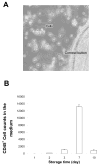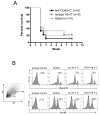Depletion of passenger leukocytes from corneal grafts: an effective means of promoting transplant survival?
- PMID: 19136708
- PMCID: PMC2739689
- DOI: 10.1167/iovs.08-1899
Depletion of passenger leukocytes from corneal grafts: an effective means of promoting transplant survival?
Abstract
Purpose: To develop and compare effective strategies for depleting graft-derived passenger leukocytes that include antigen-presenting cells from corneal buttons and to assess the effectiveness of this strategy in promoting graft survival using a high-risk (HR) model of corneal transplantation.
Methods: Corneal buttons harvested from C57BL/6 mice were used in three ex vivo strategies of passenger leukocyte depletion. Two strategies involved storage in medium at different temperatures for prolonged periods. A third strategy used complement-dependent cytotoxicity (CDC) by treating the buttons with anti-CD45 mAb plus complement. Wholemount corneal buttons or cells from enzyme-digested corneas were analyzed using confocal microscopy or flow cytometry, respectively, for the pan-leukocyte surface marker CD45. HR host beds were created and used to evaluate the efficacy of passenger leukocyte depletion on transplant survival.
Results: Passenger leukocyte numbers in the buttons were significantly reduced by all three treatments. CDC was the most efficient strategy for passenger leukocyte depletion with 39% reduction (P < 0.00005) of CD45(+) cells, and negligible damage to the endothelial layer, achievable within 24 hours. However, passenger leukocyte depletion failed to improve HR graft longevity.
Conclusions: Anti-CD45 antibody plus complement-mediated targeting of donor tissue is the most efficient way to deplete corneal passenger leukocytes and can considerably reduce the time required for cell depletion. However, depletion of graft passenger leukocytes does not have a significant effect on promoting graft survival even in the HR setting.
Figures





Similar articles
-
Prevention and restoration of second-set liver allograft rejection in presensitized mice: the role of "passenger" leukocytes, donor major histocompatibility complex antigens, and host cytotoxic effector mechanisms.Transplantation. 1999 Feb 15;67(3):444-50. doi: 10.1097/00007890-199902150-00018. Transplantation. 1999. PMID: 10030293
-
Local Delivery of Regulatory T Cells Promotes Corneal Allograft Survival.Transplantation. 2019 Jan;103(1):182-190. doi: 10.1097/TP.0000000000002442. Transplantation. 2019. PMID: 30247445 Free PMC article.
-
The function of donor versus recipient programmed death-ligand 1 in corneal allograft survival.J Immunol. 2007 Sep 15;179(6):3672-9. doi: 10.4049/jimmunol.179.6.3672. J Immunol. 2007. PMID: 17785803
-
Deletion of the chemokine receptor CCR1 prolongs corneal allograft survival.Invest Ophthalmol Vis Sci. 2007 Mar;48(3):1228-36. doi: 10.1167/iovs.05-1483. Invest Ophthalmol Vis Sci. 2007. PMID: 17325167 Free PMC article.
-
The taming of the shrew? The immunology of corneal transplantation.Acta Ophthalmol. 2009 Aug;87(5):488-97. doi: 10.1111/j.1755-3768.2009.01596.x. Acta Ophthalmol. 2009. PMID: 19664109 Review.
Cited by
-
Time- and Stimulus-Dependent Characteristics of Innate Immune Cells in Organ-Cultured Human Corneal Tissue.J Innate Immun. 2022;14(2):98-111. doi: 10.1159/000516669. Epub 2021 Jun 28. J Innate Immun. 2022. PMID: 34182556 Free PMC article.
-
High-risk corneal allografts: A therapeutic challenge.World J Transplant. 2016 Mar 24;6(1):10-27. doi: 10.5500/wjt.v6.i1.10. World J Transplant. 2016. PMID: 27011902 Free PMC article. Review.
-
AIP1 suppresses neovascularization by inhibiting the NOX4-induced NLRP3/NLRP6 imbalance in a murine corneal alkali burn model.Cell Commun Signal. 2022 May 6;20(1):59. doi: 10.1186/s12964-022-00877-5. Cell Commun Signal. 2022. PMID: 35524333 Free PMC article.
-
Role of Immune Cell Diversity and Heterogeneity in Corneal Graft Survival: A Systematic Review and Meta-Analysis.J Clin Med. 2021 Oct 12;10(20):4667. doi: 10.3390/jcm10204667. J Clin Med. 2021. PMID: 34682792 Free PMC article. Review.
-
Therapeutic approaches for induction of tolerance and immune quiescence in corneal allotransplantation.Cell Mol Life Sci. 2018 May;75(9):1509-1520. doi: 10.1007/s00018-017-2739-y. Epub 2018 Jan 6. Cell Mol Life Sci. 2018. PMID: 29307015 Free PMC article. Review.
References
-
- Dana M, Qian Y, Hamrah P. Twenty-five-year panorama of corneal immunology: emerging concepts in the immunopathogenesis of microbial keratitis, peripheral ulcerative keratitis, and corneal transplant rejection. Cornea. 2000;19:625–643. - PubMed
-
- Streilein JW, Yamada J, Dana MR, Ksander BR. Anterior chamber-associated immune deviation, ocular immune privilege, and orthotopic corneal allografts. Transplant Proc. 1999;31:1472–1475. - PubMed
-
- Hall B, Dorsch S. Cells mediating allograft rejection. Immunol Rev. 1984:31–59. - PubMed
-
- Boisgerault F, Liu Y, Anosova N, Ehrlich E, Dana MR, Benichou G. Role of CD4+ and CD8+ T Cells in allorecognition: lessons from corneal transplantation. J Immunol. 2001;167:1891–1899. - PubMed
-
- Game DS, Lechler RI. Pathways of allorecognition: implications for transplantation tolerance. Transpl Immunol. 2002;10:101–108. - PubMed
Publication types
MeSH terms
Substances
Grants and funding
LinkOut - more resources
Full Text Sources
Research Materials
Miscellaneous

